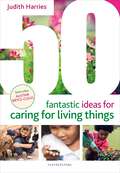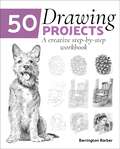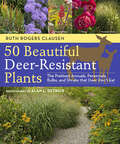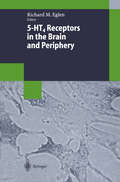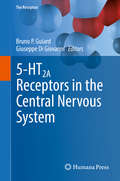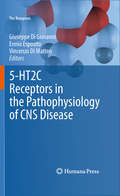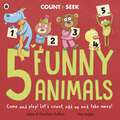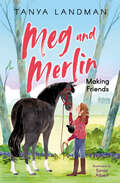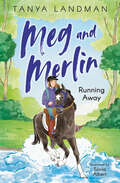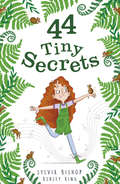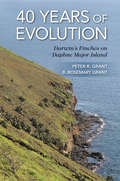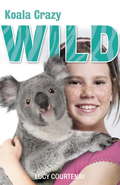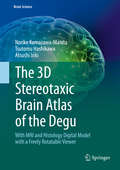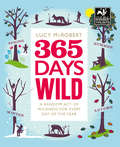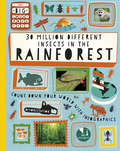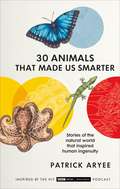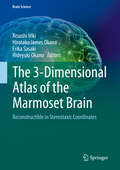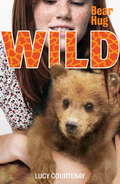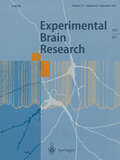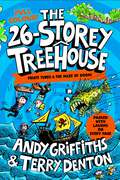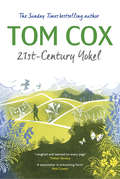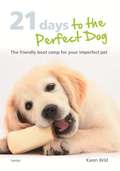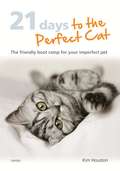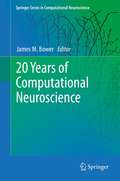- Table View
- List View
50 Fantastic Ideas for Caring for Living Things (50 Fantastic Ideas)
by Judith HarriesA brilliant collection of activities for teaching children to care for animals and plants.The ideas in this book will enable children to experience the delights of watching animals and plants grow, sharing and caring for pets, observing a variety of life-cycles, surveying different minibeasts and finding out how to help vulnerable wild animals like hedgehogs. Linked to the Understanding the World section of the EYFS framework, this book includes ideas for games, creative activities, role play and hands-on experiences with animals and plants to build children's empathy and encourage respect for living things, both in their own environments and further afield.With over 40 books in the 50 Fantastic Ideas series there's something for everyone – whether you're a practitioner looking for new ideas or you want to try out a popular well-loved activity with a new twist. Each book offers a wide range of fun and creative activities to carry out with children aged 0–5 years, with lists of resources, step-by-step instructions and information about the benefits for children.
50 Drawing Projects: A Creative Step-by-Step Workbook
by Barrington BarberIn this imaginative new book, Barrington Barber presents an array of interesting subjects, including people, pets and everyday objects in and around the home. Each project is broken down into easy-to-follow steps which culminate in a finished drawing. The reader is then invited to make his or her own version of the subject. Combining guidance for beginners with challenging subjects for more experienced artists, 50 Drawing Projects is a relaxing way to discover and develop one of life's most rewarding creative skills.Subjects include:• Still lifes• Animals• Flowers• People
50 Beautiful Deer-Resistant Plants: The Prettiest Annuals, Perennials, Bulbs, and Shrubs that Deer Don't Eat
by Ruth Rogers ClausenOffering a wonderful array of potential plant combinations with other deer-resistant varieties, Clausen shows readers how to create a gorgeous garden and still keep deer at bay.
5-HT4 Receptors in the Brain and Periphery (Biotechnology Intelligence Unit)
by Richard M. EglenThis book provides a comprehensive, up-to-date review of the distribution, pharmacology and physiology of central 5-hydroxytryptamine (5-HT)4 receptors. The 5-HT receptor subtypes exhibit a unique pharmacology, distribution and function, of which the 5-HT4 receptor has been one of the most intensively studied in recent years, both from a basic research standpoint and as a target for novel therapeutics.
5-HT2A Receptors in the Central Nervous System (The Receptors #32)
by Bruno P. Guiard Giuseppe Di Giovanni5-HT2A receptors are G-protein coupled receptors that are widely distributed throughout the brain, most notably on neuronal and glial cells. 5-HT2A receptors have been implicated in various central physiological functions including mood regulation, memory, sleep, nociception, eating, and reward behaviors, and they are also believed to control the cardiovascular system. This book provides a comprehensive overview of these receptors including sections on their properties and distribution, approaches for their study, their role in a number of brain functions and diseases, and their role as therapeutic targets.
5-HT2C Receptors in the Pathophysiology of CNS Disease (The Receptors #22)
by Giuseppe Di Giovanni, Ennio Esposito and Vincenzo Di MatteoPart of Springer’s “The Receptors,” series, this text is the first ever overview on the research of 5-HT2c receptors. 5-HT2c receptor research has been productive for twenty-five years, but recent years have seen an extraordinary increase in both amount produced and insight gained. 5-HT2c is a prominent central serotonin receptor subtype widely expressed within the central and the peripheral nervous system and is thought to play a key role in the regulation of numerous behaviors. This text covers the molecular, cellular, anatomical, biochemical and behavioral aspects of this receptor, highlighting its distinctive regulatory properties and the emerging functional significance of constitutive activity and RNA-editing in vivo. It also investigates the receptors’ therapeutic potential in many diseases, treated individually in separate chapters, including depression, drug abuse, schizophrenia, eating disorders, Parkinson’s disease, Prader-Willi Syndrome, Alzheimer’s disease and epilepsy.
5 Funny Animals: a counting and number bonds picture book
by Adam Guillain Charlotte GuillainCount and spot the animals in this fun, rhyming picture book!From racing bears, to bouncing frogs and sailing goats, this counting and number bonds picture book encourages children to learn basic sums through play and interactivity.The perfect maths book for 4 year olds to 6 year olds. With playful characters to spot and bouncy rhyming text to support their early learning in a fun way.
4u2read,Meg and Merlin – Meg and Merlin: Making Friends (4u2read,Meg and Merlin)
by Tanya LandmanWhen a pony appears in her garden on Meg’s tenth birthday, it feels like all of her wishes have been answered. But is it all too good to be true? Award-winning author Tanya Landman brings a fresh perspective to horse riding stories with a heart-warming new series of friendship and dreaming big.
4u2read – Meg and Merlin: Running Away (4u2read)
by Tanya LandmanA ride in the countryside spirals out of control for Meg and Merlin in this dramatic new addition to Tanya Landman’s lovable horse-riding series
44 Tiny Secrets (44 Tiny Secrets #1)
by Sylvia BishopThe first book in a heartwarming and timeless new series with a brave and spirited heroine, from the acclaimed duo behind THE BOOKSHOP GIRL. Betsy Bow-Linnet is determined to become a world famous concert pianist like her parents. There’s just one problem: no matter how hard she practises she doesn't share their musical talents. So when a mysterious letter arrives from a woman claiming to know of an unusual Method that will make Betsy’s playing ‘stupendous’, Betsy jumps at the chance. There's just one condition: she must keep the Method a secret. But it isn't just one secret – it's forty-four tiny secrets in the shape of a boxful of pygmy mice! Betsy is mystified – how are they going to help her play the piano and – more importantly – how on earth can she keep them all a secret? Gorgeously illustrated in two-colour, this is a warm, funny and pitch-perfect story about the true nature of family love and finding your real talents in the most unexpected of places. Perfect for fans of ISADORA MOON, AMELIA FANG, OTTOLINE and HARPER.
40 Years of Evolution: Darwin's Finches on Daphne Major Island
by Peter R. Grant B. Rosemary GrantRenowned evolutionary biologists Peter and Rosemary Grant have produced landmark studies of the Galápagos finches first made famous by Charles Darwin. In How and Why Species Multiply, they offered a complete evolutionary history of Darwin's finches since their origin almost three million years ago. Now, in their richly illustrated new book, 40 Years of Evolution, the authors turn their attention to events taking place on a contemporary scale. By continuously tracking finch populations over a period of four decades, they uncover the causes and consequences of significant events leading to evolutionary changes in species.The authors used a vast and unparalleled range of ecological, behavioral, and genetic data--including song recordings, DNA analyses, and feeding and breeding behavior--to measure changes in finch populations on the small island of Daphne Major in the Galápagos archipelago. They find that natural selection happens repeatedly, that finches hybridize and exchange genes rarely, and that they compete for scarce food in times of drought, with the remarkable result that the finch populations today differ significantly in average beak size and shape from those of forty years ago. The authors' most spectacular discovery is the initiation and establishment of a new lineage that now behaves as a new species, differing from others in size, song, and other characteristics. The authors emphasize the immeasurable value of continuous long-term studies of natural populations and of critical opportunities for detecting and understanding rare but significant events.By following the fates of finches for several generations, 40 Years of Evolution offers unparalleled insights into ecological and evolutionary changes in natural environments.
40 Years of Evolution: Darwin's Finches on Daphne Major Island (PDF)
by Peter R. Grant B. Rosemary GrantRenowned evolutionary biologists Peter and Rosemary Grant have produced landmark studies of the Galápagos finches first made famous by Charles Darwin. In How and Why Species Multiply, they offered a complete evolutionary history of Darwin's finches since their origin almost three million years ago. Now, in their richly illustrated new book, 40 Years of Evolution, the authors turn their attention to events taking place on a contemporary scale. By continuously tracking finch populations over a period of four decades, they uncover the causes and consequences of significant events leading to evolutionary changes in species.The authors used a vast and unparalleled range of ecological, behavioral, and genetic data--including song recordings, DNA analyses, and feeding and breeding behavior--to measure changes in finch populations on the small island of Daphne Major in the Galápagos archipelago. They find that natural selection happens repeatedly, that finches hybridize and exchange genes rarely, and that they compete for scarce food in times of drought, with the remarkable result that the finch populations today differ significantly in average beak size and shape from those of forty years ago. The authors' most spectacular discovery is the initiation and establishment of a new lineage that now behaves as a new species, differing from others in size, song, and other characteristics. The authors emphasize the immeasurable value of continuous long-term studies of natural populations and of critical opportunities for detecting and understanding rare but significant events.By following the fates of finches for several generations, 40 Years of Evolution offers unparalleled insights into ecological and evolutionary changes in natural environments.
4: Koala Crazy (WILD #4)
by Lucy CourtenayFeaturing tiger cubs, circus bears, swimming monkeys and cute koalas - this is a must-read series for all animal lovers!Twins Tori and Taya Wild disagree about almost everything ... except for their love of animals. Which is good since their mother fosters all kinds of wild animals so their house is always full of them! And now their family has set up an 'animals on film' business their lives have become even WILDER. It was only a matter of time before Tori and Taya had their chance to be on the set of a famous music video when Taya's baby croc is selected to star on a snappy rap video ... And when the twins aren't busy with crocs, it's cute Koco the-kangeroo-loving koala bear who is grabbing their attention. When he goes missing things at Wild World get a bit koala crazy!Check out these other titles in the series: Tiger Trouble, Monkey Magic, Bear Hug
The 3D Stereotaxic Brain Atlas of the Degu: With MRI and Histology Digital Model with a Freely Rotatable Viewer (Brain Science)
by Noriko Kumazawa-Manita Tsutomu Hashikawa Atsushi IrikiThis book is the first digital atlas of the degu brain with microscopic features simultaneously in Nissl sections and magnetic resonance imaging (MRI). As an experimental animal model, the degu contributes to a variety of medical research fields in diabetes, hyperglycemia, pancreatic function, and adaptation to high altitude, among others. Recently the degu has gained increasing importance in the field of neuroscience, particularly in studies evaluating the relationship between sociality and cognitive brain functions, and in studies pertaining to the evolutional aspects of the acquisition of tool-use abilities. Furthermore, aging-related brain dysfunction in humans can be studied using this animal model in addition to mammals with much longer lifespans. This brain atlas is constructed to provide histological and volume-rendered information simultaneously, fitting with any spatial coordination in brain positioning. It can be a useful guide to degus as well as to other rodents for studies of brain structures conducted using MRI or other contemporary examination methods with volume-rendering functions.
365 Days Wild
by Lucy McRobert365 inspirational suggestions for enjoying nature. These 'Random Acts of Wildness' will encourage you to fall in love with, learn about or even help wildlife and wild places near you.
30 Million Different Insects in the Rainforest (The Big Countdown #2)
by Paul RockettYou can count numbers all around you, from the eight legs on a spider to the one nose on your face. But can you the animal species found in the rainforest or the fish in the River Amazon? Find out all about RAINFOREST in THE BIG COUNTDOWN, including its extraordinary variety of plant and animal life, its tribal people, its layered structure, its role as an oxygen producer and why we need to protect it.The Big Countdown looks at popular topics and investigates the great many numbers that make them fascinating. From the mind-bogglingly large to smallest and most precious, this series helps us understand that it's not just our days that are numbered.
30 Animals That Made Us Smarter
by Patrick AryeeDid you know that mosquitoes' mouthparts are helping to develop pain-free surgical needles? Who'd have thought that the humble mussel could inspire so many useful things, from plywood production to a 'glue' that cements the crowns on teeth and saves unborn babies in the womb? How about the fact that studying the tiny kingfisher solved engineering problems with Japan's ultra-high-speed bullet train, or that the humpback whale's flipper helped design the most efficient blades for wind power turbines? For many years, humans have been using the natural world as inspiration for everything from fashion to architecture, and medicine to transport, and it may come as a surprise to learn how many inventions have been motivated by animal design and behaviour. Dive into the depths with us as author Patrick Aryee reveals even more astonishing stories about animals' exceptional powers and the unique contributions they've made to the quality of our everyday lives. Beautiful hand-drawn illustrations accompany his revelations and bring the natural world to life.
The 3-Dimensional Atlas of the Marmoset Brain: Reconstructible In Stereotaxic Coordinates (Brain Science)
by Atsushi Iriki Hirotaka James Okano Erika Sasaki Hideyuki OkanoThis book provides accurate, comprehensive, and convenient reference for usages of the “freely rotatable three dimensional combined Nissl-stained and MRI digital data of the marmoset brain”. The key features of the original 3D digital data and of this atlas are: 1. The original digital datasets are freely rotatable in three dimensions, thus expected to be useful for any disciplines and anatomical interest, using any coordinate system, 2. Combined Nissl stained and MRI images are obtained from the same marmoset, to allow cross-modality matched references for multiple usages, 3. 86 Horizontal Series of Images with Neurosurgical Plane (based on the actual data), with more accuracy and resolution (Chapter 2) than the web-based digital images, 4. 32 Coronal Series of Images with Neurosurgical Plane (reproduced from the brain model) (Chapter 3), 5. 10 Parasagittal Series of Images with Neurosurgical Plane (reproduced from the brain model) (Chapter 4), 6. 3 Omnidirectionally Sliceable Planes (reproduced from the brain model) (Chapter 5), 7. In order to provide higher resolution structures to match systematic accuracy for supplementation of the digital data on the website, additional information are included. They are: 1) Nomenclature, 2) List of Brain Structures in Hierarchical Order, 3) Index of Abbreviations, together with 143 useful Bibliographic References list as of 2016, 8. Horsley-Clarke’s stereotaxic coordinates were adopted in the present atlas.
3: Bear Hug (WILD #3)
by Lucy CourtenayFeaturing tiger cubs, circus bears, swimming monkeys and cute koalas - this is a must-read series for all animal lovers!Twins Tori and Taya Wild disagree about almost everything ... except for their love of animals! That's a good thing, too, since their mother fosters all kinds of wild animals so their house is always full of them! And now their family has set up an 'animals on film' business their lives have become even WILDER. When her father has to find a cast of horses for a TV period drama Taya thinks it's finally her time to be the STAR. She's desperate to be the one in front of the camera for once. But she's in danger of being upstaged by Boris, the tiny Russian circus bear cub her mum is fostering, who could end up stealing the show ...
29th Annual General Meeting of the European Brain and Behaviour Society (Experimental Brain Research Series)
by Nicole von Steinbüchel Alexander Steffen Marc WittmannThe 26-Storey Treehouse: Colour Edition (The Treehouse Series #2)
by Andy GriffithsThe 26-Storey Treehouse: Colour Edition is the second book in the bestselling Treehouse series by Andy Griffith's and Terry Denton! This laugh-out-loud story is packed with and told through fantastic comic book style illustrations – perfect for fans of Dog Man and Bunny vs. Monkey. 'The kind of book I would have loved as a kid' – Tom Fletcher, author of The Danger Gang. Andy and Terry have expanded their treehouse! There are now thirteen brand-new storeys, including a dodgem-car rink, a skate ramp, a mud-fighting arena, an antigravity chamber, an ice-cream parlour with seventy-eight flavours run by an ice-cream-serving robot called Edward Scooperhands, and the Maze of Doom – a maze so complicated that nobody who has gone in has ever come out again . . . Well, not yet anyway.This time, the two friends have a whole week to finish their next book, and Andy even knows what it should be about: the story of how he and Terry first met. But life is NEVER boring in the treehouse, and emergency shark operations, giant storms, and wooden pirate heads are just the beginning . . .Well, what are you waiting for? Come on up!Climb more fun-filled levels in the ten million-copy-selling series – the perfect chapter books for reluctant readers.
21st-Century Yokel: Cats Of The River (Tom Cox's Country Yokel Posters Ser.)
by Tom Cox21st-Century Yokel explores the way we can be tied inescapably to landscape, whether we like it or not, often through our family and our past. It’s not quite a nature book, not quite a humour book, not quite a family memoir, not quite folklore, not quite social history, not quite a collection of essays, but a bit of all six.It contains owls, badgers, ponies, beavers, otters, bats, bees, scarecrows, dogs, ghosts, Tom’s loud and excitable dad and, yes, even a few cats. It’s full of Devon’s local folklore – the ancient kind, and the everyday kind – and provincial places and small things. But what emerges from this focus on the small are themes that are broader and bigger and more definitive.The book’s language is colloquial and easy and its eleven chapters are discursive and wide-ranging, rambling even. The feel of the book has a lot in common with the country walks Tom Cox was on when he composed much of it: it’s bewitched by fresh air, intrepid in minor ways, haunted by weather and old stories and the spooky edges of the outdoors, restless, sometimes foolish, and prone to a few detours... but it always reaches its intended destination.The book is illustrated with Tom’s own landscape photographs and linocuts by his mother.
21 Days To The Perfect Dog: The friendly boot camp for your imperfect pet
by Karen WildSimple, structured and effective, this 21-day course will prevent problem behaviour and, over subsequent days, encourage positive interaction, so that your dog continues to behave well. Exercises are given for each day in the training plan, with reinforcement of the previous day's learning scheduled in, as well as time for relaxation and play with your dog.The first section helps you to assess your key concerns so that you can tailor the programme to fit your needs, while a 'quick fix' section after the main training plan providing you with 50 speedy solutions to common problems, such as damaging furniture or unsociable behaviour towards strangers.Easy to fit in around your life, with this book you are just 21 training days away from the perfect dog.
21 Days To The Perfect Cat: The friendly boot camp for your imperfect pet
by Kim HoustonSimple, structured and effective, this 21-day course will prevent problem behaviour and, over subsequent days, encourage positive interaction, so that your cat continues to behave well. Exercises are given for each day in the training plan, with reinforcement of the previous day's learning scheduled in, as well as time for relaxation and play with your cat.The first section helps you to assess your key concerns so that you can tailor the programme to fit your needs, while a 'quick fix' section after the main training plan providing you with 50 speedy solutions to common problems, such as damaging furniture or unsociable behaviour towards strangers.Easy to fit in around your life, with this book you are just 21 training days away from the perfect cat.
20 Years of Computational Neuroscience (Springer Series in Computational Neuroscience #9)
by James M BowerWhen funding agencies and policy organizations consider the role of modeling and simulation in modern biology, the question is often posed, what has been accomplished ? This book will be organized around a symposium on the 20 year history of the CNS meetings, to be held as part of CNS 2010 in San Antonio Texas in July 2010. The book, like the symposium is intended to summarize progress made in Computational Neuroscience over the last 20 years while also considering current challenges in the field. As described in the table of contents, the chapter’s authors have been selected to provide wide coverage of the applications of computational techniques to a broad range of questions and model systems in neuroscience. The proposed book will include several features that establish the history of the field. For each article, its author will select an article originally appearing in a CNS conference proceedings from 15 – 20 years ago. These short (less than 6 page) articles will provide illustrations of the state of the field 20 years ago. The new articles will describe what has been learned about the subject in the following 20 years, and pose specific challenges for the next 20 years. The second historical mechanism will be the reproduction of the first 12 years of posters from the CNS meeting. These posters in and of themselves have become famous in the field (they hang in the halls of the NIH in Bethesda Maryland) and were constructed as allegories for the state and development of computational neuroscience. The posters were designed by the book’s editor, who will, for the first time, provide a written description of each poster.
